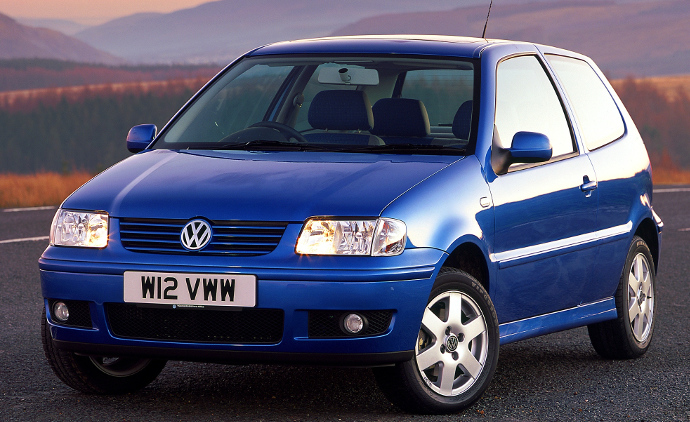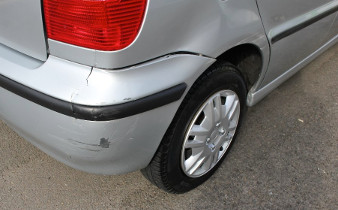For a classy and soon to be classic runaround, look no further than the third and fourth generation or Polo Mk4/5 made between 1994 and 2003. Officially designated the 6N/6N2, they are buttons to buy, cheap to maintain and easy to tweak if the fancy takes you. There’s lots of badly neglected ones out there though, so the secret when buying one though is to weed out the real rough ones and to help we’ve put together the following guide on what to look for…

Model Guide
There were a raft of engine options when the 6N first broke cover in ‘94, including a 1.0, 1.3 and 1.6. The 60bhp 1.4 arrived in 1995 and the 64bhp 1.9 diesel first appeared in non-turbo guise in 1996. The most pokey Polo from this era was the 16v 1.4 firecracker which came along in the same year, while a usefully quick and frugal turbo’d version of the diesel with 90bhp debuted in 1998. There was also a 100bhp 1.6 from around that time which was good for 116mph and could do 0-60mph in 10.7, which was just a tad slower than the 10.5 seconds recorded for the valver 1.4.

The 6N became the 6N2 from 1999 when it received a front and rear end makeover, along with the latest Lupo’s interior and twin front airbags as standard. A new three-cylinder 75bhp 1.4 turbodiesel was added to the range, along with a 125bhp 1.6 16v GTi model that could do 0-60 in just 8.7 seconds as well as the universally acclaimed 110bhp 1.9 TDi.


There was also a four-door saloon version of the 6N from 1997 (which was only available with the 1.6 and 1.9 SDi initially) and a handy five-door estate from 1998 which came with either a 1.6 or 1.9 diesel under the bonnet.
Engines
As always, proof of regular maintenance is paramount so if you’re not convinced that the Polo you are looking at has had regular oil and filter changes (every 8-10,000 miles) it might be best to walk away and find another one that has. Beware TDi models that haven’t been run on the right spec oil as gunked up variable vane turbo issues are commonplace. Cambelt replacement is due every 60,000 miles or four years, so if it’s coming up haggle the price down accordingly (by about £400, ideally).

Any rough running could be down to throttle body problems or sensor issues. Gearboxes are strong, although the exception is the one fitted to the 1.4 TDi which is a little more fragile when it comes to synchromesh failure. Obviously any models fitted with dual mass flywheel (such as the later turbodiesels and the GTi) could prove pricy if there’s vibration in the system.
Bodywork
With the oldest ones now over 20 years old, rust can be a real issue. The worst hit areas include the bottom of the doors, wheel arches, sills, front and rear aprons, the metal around the windscreen rubbers front and rear and the boot floor if water has been allowed to get in. Rust can also break out behind the various bits of body trim, so look there too. The post facelift 6N2 had better rust proofing, but don’t take anything for granted.


Being a regular visitor to supermarket car parks, also check down the sides for parking dings and bust plastic bumpers which can be a real pain to make look good again. Scruffy alloys can also be a turn-off.
Running Gear
There really shouldn’t be too much to worry about here on a cared-for car, but you could easily empty your wallet catching up with jobs on one that’s been neglected. Especially if you find out the electric windows have stopped working (common), the central locking’s playing up (also common) and you need to replace most of the suspension bushes (the lower wishbone bushes always go). Wheel bearings are also a notorious weak point on this car. Another common malady concerns the pedal box; the mounting bracket that’s bolted to the bulkhead gets stressed and cracks. Beware also of leaky heater matrixes, duff power steering pumps and faulty temperature sensors (hopefully most will have had the newer green four-pin sensor fitted by now).


ABS warning lights can sometime be extinguished by fitting a new module fuse, otherwise it will likely be one of the wheel sensors. Sometimes they can be cleaned but usually it’s quicker to fit a replacement.
What to pay
Incredibly the cheapest Polos from this era start at just a couple of hundred pounds which is great news because it means you can afford to be ultra choosy when viewing cars for sale. It will pay to shop around to find the best condition car with the best spec, the lowest mileage, the tidiest interior and most comprehensive service history. Don’t forget to go round the car, totting up what’s wrong and what the likely cost of putting things right might be – and opt for the car which is likely to land you with the smallest potential repair bill. Colour counts too as cars in dowdy dark metallics can look a bit miserable.

The post-facelift 6N2 looks more modern and is undoubtedly better specced inside, and because there seems to be no real discernable difference in price between those and the original 6N, they probably represent the best buys. The most sought after model is the 16v 1.4 and we spotted a mint looking 2001 on an X-plate in silver with just 52,000 miles on the clock selling for £1450 – so use that as a guide. Young drivers beware of the 1.6 because its bigger engine may hammer you when it comes to insurance premiums.
Ian
The opinions expressed here are the personal opinions of the author and do not necessarily represent the views and opinions of VW Heritage


Hi – is it possible to send me a picture of the frontof this model as not sure if it has circular or square headlights? Thanks